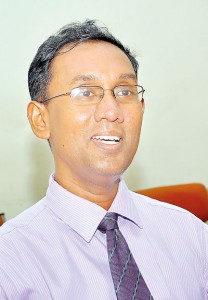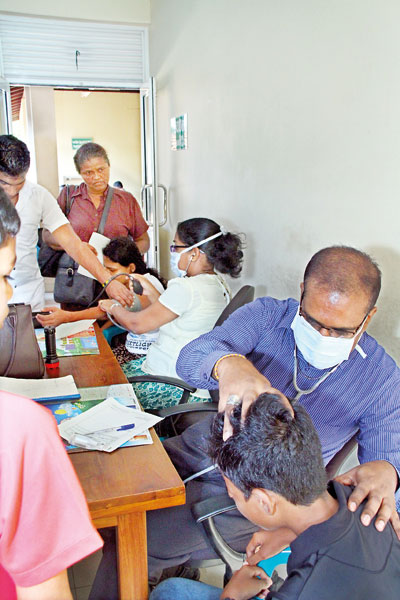News
Good news! Country recovering from bad bout of flu
 Influenza A including H1N1 or the flu seems to be on the wane. But be careful about the next peak that is usually experienced around May.
Influenza A including H1N1 or the flu seems to be on the wane. But be careful about the next peak that is usually experienced around May.
This is the good news and precautionary advice being issued this week by Consultant Virologist Dr. Jude Jayamaha who is in charge of the National Influenza Centre, Department of Virology of the Medical Research Institute (MRI).
As the country recovers from a bad bout of the flu caused by a virus which left hospitals crowded, he recalled that there were similar outbreaks of Influenza A in 2013 and 2015 and now in 2017.
The shape of the disease on a graph has been different this year. In 2013 and 2015, it took the shape of an inverted ice-cream cone with the base spreading over three months. However, in 2017, it has been more like a half-moon, with the disease rampant for more than three months, he says.
“Even into the fourth month of April, people are still sniffling, coughing and sneezing,” explains Dr. Jayamaha, pointing out that as they keep testing samples, they have determined that this year it has been Influenza A which has taken the upper hand against Influenza B.
Here are the findings of the National Influenza Centre:
* From April 1 to 15, samples tested were 889: Influenza A — 346 and Influenza B – 37. The balance samples were negative for influenza.
* March 1 to 31 samples tested were 1,795: Influenza A – 614 and Influenza B – 62
* February 1 to 28, samples tested 1,048: Influenza A – 327 and Influenza B – 79
* January 1 to 31, samples tested 558: Influenza A – 118 and Influenza B – 18

Dr. Jude Jayamaha
To why the flu lasted longer than usual, he says that as experienced worldwide, a contributory factor could be the erratic weather patterns due to global warming including morning temperatures being low, similar to those experienced in India.
Dispelling misconceptions that the influenza epidemic was caused by an “imported” virus, he is categorical that there is absolutely no truth to that. The virus has been around and will be around in the country.
Looking at Influenza A which made many people ill in the last four months, Dr. Jayamaha points out that the more dominant strain this year, was H1N1, while H3N2 was around to a lesser degree.
This they are able to determine as there is a strong National Surveillance Programme. There has been a variation in the two peaks usually experienced with regard to the flu – a higher peak in December, January and February and a shorter peak in May, June and July. It could vary slightly this way or that. This time, however, there was a lot of illness over an extended period from December lasting through to April, explains Dr. Jayamaha.
He advised everyone to take basic precautions to prevent catching the flu in the coming months of May, June, July and August. “Eat well, rest well and build up your immunity. Don’t get exposed to the flu virus unnecessarily.”
Referring to secondary infections which follow a primary infection from influenza, Dr. Jayamaha said that the influenza virus destroys the normal flora and protective epithelium of the respiratory tract. This makes the way for seemingly harmless bacteria to come in and cause a secondary infection.
His imagery is – the commandos (influenza virus) wage war and leave the respiratory tract vulnerable. Then the foot soldiers (bacteria) go in to cause more damage.
Usually, the secondary infection is caused by Acinetobacter but he confirms that a new fungal infection has been identified from the Polonnaruwa Hospital (three patients) and the Sri Jayewardenepura Hospital (one patient).

Our photographer Indika Handuwala captured people crowding the outpatients department (OPD) of the National Institute of Infectious Diseases at Angoda just before the New Year (above and top)
| Dengue still not abating By Shadya Ismail Although the number of H1N1 cases reported this month had reduced in comparison to the cases in March, dengue deaths have increased to 65 from 50 at the end of last month and 34,059 cases have been reported islandwide, a Health official said. Dengue Control Unit, Consultant Community Physician, Dr. Prechila Samaraweera said in comparison the number of deaths reported for the whole of last year was 90. She said, although the number of cases reported this month is less than in March, the numbers may rise with the onset of monsoon rains due next month. Dr. Samaraweera said in view of the school term beginning next week after the National New Year holidays, the Education Dept. had issued circulars to 26 schools instructing them to clean their premises. She added that Health Ministry officials will be inspecting these schools. She said in addition to this school programmes other awareness and inspection programmes would be conducted with special emphasis on state institutions and construction sites. |

